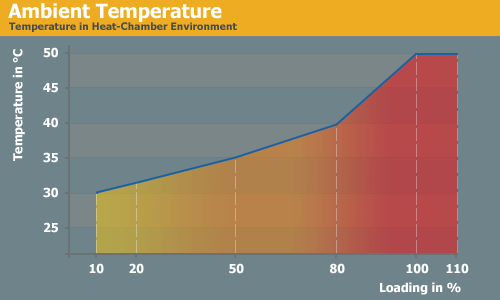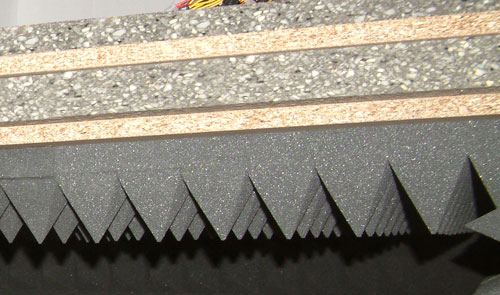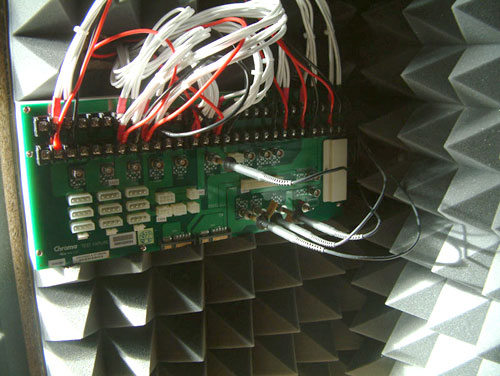Enermax Revolution 85+ High Efficiency PSU
by Christoph Katzer on November 6, 2008 4:15 AM EST- Posted in
- Cases/Cooling/PSUs
Testing with the Chroma ATE Programmable Load

Our test equipment consists of two Chroma programmable DC Loads that enable us to test power supplies with an output of up to 1500W. The biggest advantage of the Chroma DC Loads is simply the high precision it provides. It can measure differences as small as 0.001V and 0.0001A, which will provide us with best-in-class results.
When programming the Chroma with specific amounts of load calculated according to the ATX norm, we are able to load power supplies to an exact percentage. We can now show results at every specific percentage needed. To get the best overview of a power supply, we load each unit with 10%, 20%, 50%, 80%, 100%, and 110% of the specified output. This is easy to calculate for a 1000W power supply: the 10% load is 100W and 110% load is 1100W. Remember that this is the amount of power the PSU delivers; due to inefficiencies, a power supply will actually draw more power from the wall.
Note: If you would like to know more about our testing methodology, equipment, and environment, please read our PSU testing overview.
We have added an additional 10% on the highest load to see how the units perform with overload. This test will be performed in all future reviews. The overload test is performed at room temperature as well as under more stressful conditions; to ensure we are not too cruel to the power supplies, we will keep the ambient temperature at 50°C in the stress test. Experience shows that many units can stand the overload at room temperature but will experience problems with higher temperature and overload together. Only the best-built units will survive this.

The Testing Environment
There is one flaw in testing power supplies with programmable loads while trying to measure the sound pressure levels at the same time. Because the programmable loads get very loud, there is no chance of hearing the power supply on the test stand. In order to make accurate measurements of the noise levels we needed a way to separate the test unit and the programmable loads. Our solution was to build a very thick box around the unit.

We concluded that a five-layer box with a total thickness of 6" (15cm) containing two layers of wood and three layers of special foam would suffice. It is designed as a box within a box. The inner box does not touch any part of the outer box, making it difficult for acoustic noise to pass through in the form of vibration. Each box is isolated on both sides with a layer of heavy foam that is normally used to insulate engines. On the inside we have an additional layer of 4" (10cm) thick pyramidal foam on every side of the box to eliminate the acoustic waves coming from the test object as well as we can.

To ensure a completely closed system we installed the printed circuit board that the connectors of the power supply are attached to inside the anechoic room/box. In other box designs, you would need to put all the cables through the wall. Unfortunately, that would result in the inside of the box not being fully isolated anymore. Our design keeps everything that needs to be connected inside of the box and maintains isolation.










49 Comments
View All Comments
xaris106 - Thursday, November 6, 2008 - link
sorry if my english are not good. its not my first language.Aside from that i know what a kilowatt and losses are. I`m not saying they did something wrong. I just wanted some more info on the matter for the pros and cons...
araczynski - Thursday, November 6, 2008 - link
i suppose they're putting all that tech into the very high end market for the same reason as all other techs do; its easy to charge an extra premium (above the normal premium) from those buyers.sooner or later the technology will trickle down into the 'normal' market, where there is more serious volume.
but that's alright, the very high end market just ends up paying our share of the R&D costs that get passed on to them, instead of us.
'bleeding edge' or something they call it? 'bleeding' green :)
JarredWalton - Thursday, November 6, 2008 - link
The real problem is trying to get all of the necessary parts into a "reasonable" PSU, like something in the 600W or lower range for example. I'd guess they probably put around $100-$150 worth of parts and components into this design, making it fit for the high-end but not much else. If you want to sell 500W PSUs, pricing needs to be below $100 for sure to be competitive, and it's just not all that practical to get there with top-end components (IMO).Keep in mind that most people run PSUs at around 50% load if they want peak efficiency, so this PSU is really ideal for anyone running a ~500W system. GTX 280 SLI with an overclocked quad-core would be just about right I think... if you have enough extra HDDs. That it *can* run anything from 200W to 950W with 85% efficiency (and even beyond if you use 230VAC and want to overload the PSU) is extremely impressive.
Phew - Thursday, November 6, 2008 - link
"When I first saw the filtering stage, I asked the representatives at Enermax if CWT is the ODM"I consider myself pretty savvy about computer hardware, and I have two engineering degrees (mechanical), but that sentence was meaningless to me.
If you are going to use multiple obscure acronyms in one sentence, please at least include links to what they stand for and some description. It shouldn't take an electrical engineering degree to understand an article on a 'mainstream' computer hardware website.
yeti514 - Friday, November 7, 2008 - link
I don't know about this PSU, but the PSUs in the link below sure look like some Thermaltake units that were made by CWT to me.http://www.enermaxusa.com/catalog/product_info.php...">http://www.enermaxusa.com/catalog/produ...sCsid=e8...
nevbie - Thursday, November 6, 2008 - link
Channel Well Technologies (company..)Original Design Manufacturer (..which was the manufacturer)
Or along those lines.
Note that this is a mainstream enthusiast computer hardware website. =P
Phew - Thursday, November 6, 2008 - link
When your computer hardware website has a power supply review listed right next to a digital camera review and a Guitar Hero article, that is about as 'mainstream' as it gets.Thanks for the acronym explanation
petersterncan - Thursday, November 6, 2008 - link
I will never buy this line of PSUs unless they came out with a 300-350W model.The systems I build use on-board graphics, on-board audio, one HD, one energy efficient CPU and one optical drive. Fully configured, the systems I build for myself only use around 110 watts. Anything over 350W results in wasted electricity.
Look at the minimum power consumption and efficiency at low power draws! That's the most relevant info for me when selecting a PSU.
Calin - Thursday, November 6, 2008 - link
You can have in USA electrical power on 240V. And the power source will go just as well at 220/230V of Europe as with 240Vstrikeback03 - Thursday, November 6, 2008 - link
Problem would probably be getting the proper cable for the US. Might have to make it yourself.